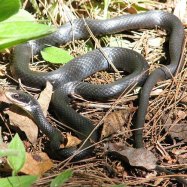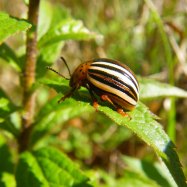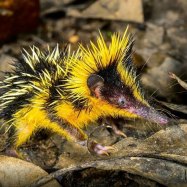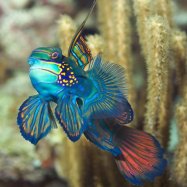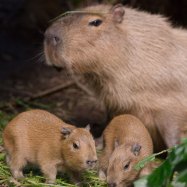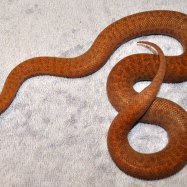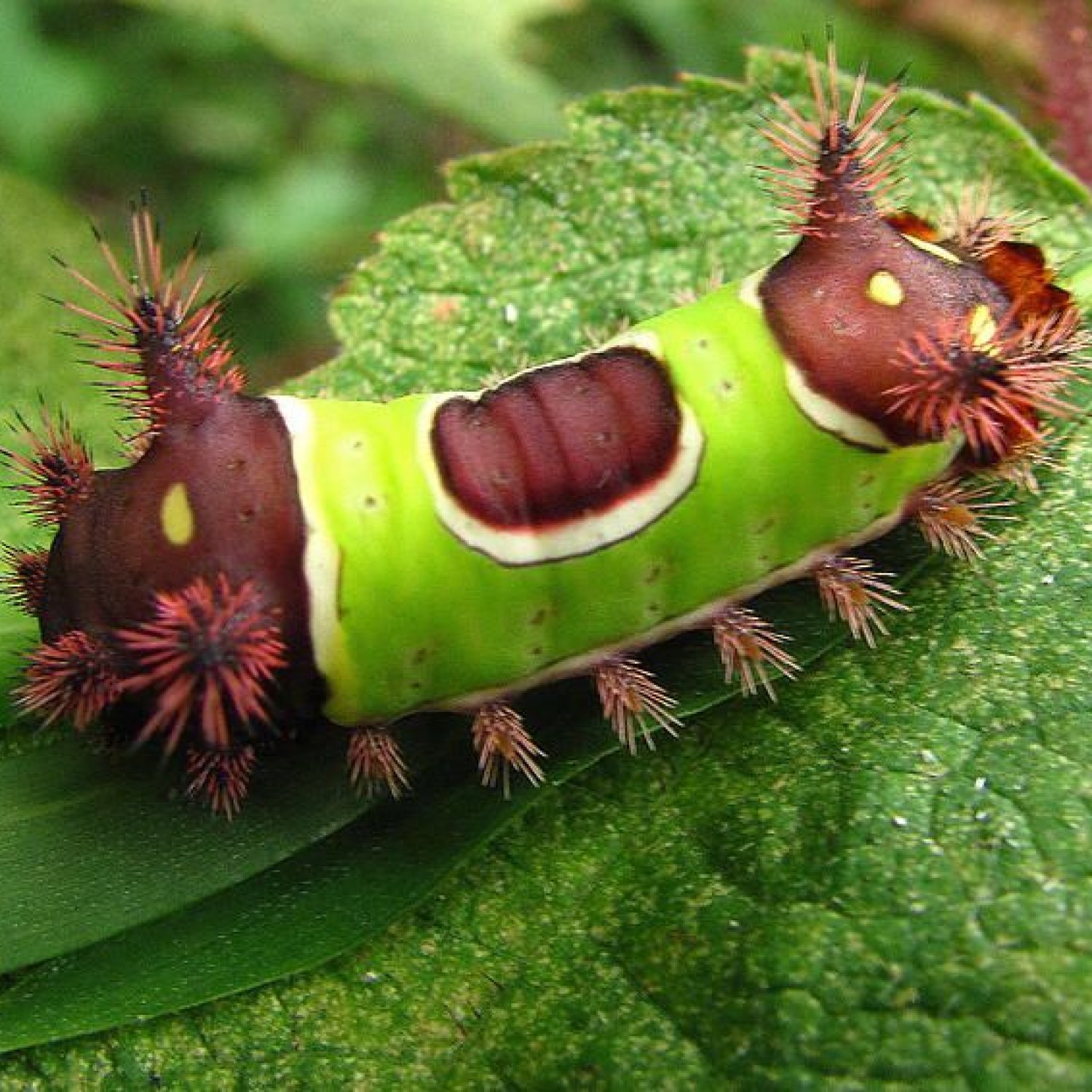
Saddleback Caterpillar
1.5 inches (3.8 cm)
The Saddleback Caterpillar may look cute with its green and brown saddle marking, but beware! Its spiky hairs can cause a painful rash. Found in Eastern and Central US, this 1.5-inch long caterpillar belongs to the Limacodidae family. Its unique body shape is what sets it apart from other caterpillars. Keep a safe distance and admire this little critter from afar!
Animal Details Summary:
Common Name: Saddleback Caterpillar
Kingdom: Animalia
Habitat: Deciduous forests, gardens, and parks
The Intriguing World of the Saddleback Caterpillar
The animal kingdom is full of interesting and unique creatures, each with its own fascinating features. Among them is the Saddleback Caterpillar, scientifically known as Acharia stimulea. This small but mighty insect is known for its distinctive coloration and its interesting life cycle. So, let's dive into the world of the Saddleback Caterpillar and uncover its secrets Saddleback Caterpillar.A Little Introduction...
The Saddleback Caterpillar is a member of the Animalia kingdom, belonging to the phylum Arthropoda and the class Insecta. Its place in the order Lepidoptera places it in the same group as butterflies and moths. The scientific name Acharia stimulea comes from the Greek word "achar", meaning thorn, and "stimulea", meaning to stimulate – a fitting name for this caterpillar's spiky appearance and painful bite.The Saddleback Caterpillar is commonly found in the eastern and central parts of the United States, making it a native species to North America. Its habitat ranges from deciduous forests to gardens and parks, where it can often be seen on plants and trees. But what makes this caterpillar so unique? Let's delve deeper into its features Sun Bear.
A Closer Look at the Saddleback Caterpillar
When fully grown, the Saddleback Caterpillar is about 1.5 inches (3.8 cm) long, making it relatively small in size. But don't let its tiny appearance fool you. This caterpillar is anything but harmless. Its bright green coloration with brown and white markings serves as a warning sign to potential predators that it is not to be messed with.Similar to other caterpillars, the body shape of the Saddleback Caterpillar is long and cylindrical. It is covered in spines or tiny hairs, giving it a prickly appearance. These spines not only serve as a deterrent to predators, but they also contain a toxic venom that can cause severe reactions in humans, as well.
The Life Cycle of the Saddleback Caterpillar
The Saddleback Caterpillar goes through a complete metamorphosis, meaning it undergoes distinct stages of development – from egg to larva to pupa to adult. This process can take anywhere from four to six weeks, depending on environmental conditions.The first stage begins with the adult female moth laying eggs on the underside of leaves. These eggs are flat, round, and have a light green color. After about a week, the eggs hatch, and the tiny caterpillars emerge. In their larval stage, these caterpillars feed on a variety of plants, including oak, apple, cherry, and maple.
As the caterpillars continue to eat and grow, their colors intensify, and their spines become more prominent. When they reach their final larval stage, they become fully grown and are ready to pupate. This is when they attach themselves to twigs or other surfaces and spin a cocoon around them, where they will undergo the transformation into an adult moth.
The adult Saddleback Moth is not as well-studied as the caterpillar, but it typically has a brownish-gray color with two white spots on its wings. They are nocturnal creatures, so they are not as commonly seen as their larval form.
Unique Adaptations and Survival Techniques
The Saddleback Caterpillar has several unique adaptations that help it survive in the wild. One of its most notable features is its appearance, which serves as a protective mechanism against predators. The bright coloration with white and brown markings mimics the appearance of a saddle, giving it its common name.In addition, the spines or hairs on the caterpillar's body act as a defense mechanism against predators. They contain a venom that can cause a burning sensation, redness, and swelling when they come into contact with human skin. This venom is not life-threatening, but it can cause discomfort and irritation, earning the Saddleback Caterpillar the nickname "asp caterpillar" or "puss caterpillar."
Furthermore, the Saddleback Caterpillar has an interesting survival technique called "rolling." When threatened, it can tuck its legs and head into its body and curl up into a ball, similar to a roly-poly bug. This behavior helps to protect its softer underside, which is not covered in spines.
The Impact of Saddleback Caterpillars in Nature
Despite its toxic venom and distinctive appearance, the Saddleback Caterpillar plays an essential role in its ecosystem. As herbivorous creatures, they consume leaves, helping with nutrient cycling and maintaining plant populations. They also serve as a food source for predators like birds, spiders, wasps, and other insects.However, excessive populations of these caterpillars can have negative impacts on plants and trees. In some cases, their feeding can cause defoliation, leading to stunted growth or even death of plants. As such, natural control measures, like predation and parasitism, help keep their populations in check.
A Word of Caution
While exploring the great outdoors, it's essential to keep an eye out for the Saddleback Caterpillar and avoid direct contact with them. The venom in their spines can cause significant irritation and discomfort, and in rare cases, an allergic reaction. If you do come into contact with one accidentally, make sure to wash the affected area with soap and water and seek medical attention if necessary.In Conclusion
The Saddleback Caterpillar is a small yet fascinating creature that exemplifies the beauty and complexity of nature. Its distinctive coloration, unique adaptations, and interesting life cycle make it a must-see for any nature enthusiast. While they may not be the most friendly critters, they play an essential role in their ecosystem and serve as a reminder of the delicate balance of nature.So, next time you come across a bright green and spiky creature in the wild, you'll know that it's no ordinary caterpillar – it's the Saddleback Caterpillar.

Saddleback Caterpillar
Animal Details Saddleback Caterpillar - Scientific Name: Acharia stimulea
- Category: Animals S
- Scientific Name: Acharia stimulea
- Common Name: Saddleback Caterpillar
- Kingdom: Animalia
- Phylum: Arthropoda
- Class: Insecta
- Order: Lepidoptera
- Family: Limacodidae
- Habitat: Deciduous forests, gardens, and parks
- Feeding Method: Herbivorous
- Geographical Distribution: North America
- Country of Origin: United States
- Location: Eastern and Central United States
- Animal Coloration: Varies, but typically bright green with brown and white markings
- Body Shape: Caterpillar
- Length: 1.5 inches (3.8 cm)

Saddleback Caterpillar
- Adult Size: 1 inch (2.5 cm)
- Average Lifespan: About 2 weeks in the caterpillar stage
- Reproduction: Sexual
- Reproductive Behavior: Females lay eggs in clusters on the undersides of leaves
- Sound or Call: Does not produce sound or call
- Migration Pattern: Non-migratory
- Social Groups: Solitary
- Behavior: Active during the day (diurnal), feeds on a variety of plant species
- Threats: Predators such as birds and spiders
- Conservation Status: Not evaluated
- Impact on Ecosystem: Can defoliate trees, but typically not considered a major threat
- Human Use: No significant human use
- Distinctive Features: Prominent green saddle-shaped marking on the back
- Interesting Facts: The spines on its body are venomous and can cause skin irritation
- Predator: Birds, spiders
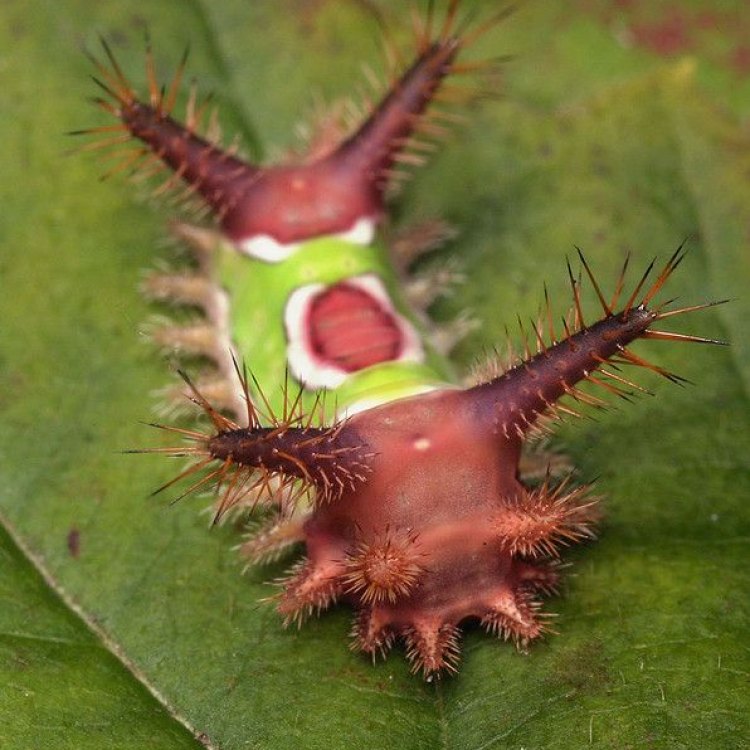
Acharia stimulea
The Fascinating World of the Saddleback Caterpillar
Nature is full of incredible creatures, many of which we may never have the chance to encounter. However, if you come across a small, inch-long caterpillar with a distinctive green saddle on its back, you have just met the fascinating Saddleback Caterpillar.With its unique appearance and interesting behaviors, the Saddleback Caterpillar has captured the attention of biologists and nature enthusiasts alike. This tiny creature has many unique features that make it stand out in the insect world PeaceOfAnimals.Com. Let's take a closer look at this intriguing species and discover what makes it so special.
Appearance and Size
The Saddleback Caterpillar (Acharia stimulea) is a member of the moth family Limacodidae, commonly known as the slug caterpillars. It is a small but striking creature, with a bright green body and a distinct saddle-shaped marking on its back that gives it its name. The rest of its body is covered in spines, which give it a fuzzy appearance.
When fully grown, the Saddleback Caterpillar typically reaches a size of around 1 inch (2.5 cm) in length, making it one of the larger caterpillar species. Despite its size, it is quite nimble and can move quickly, using its many legs to navigate through its surroundings.
Lifecycle and Reproduction
The Saddleback Caterpillar goes through a complete metamorphosis, with four distinct stages in its lifecycle: egg, larva, pupa, and adult. The average lifespan of a Saddleback Caterpillar is about two weeks, which is relatively short compared to other caterpillar species Scorpion Fish.
Reproduction in Saddleback Caterpillars is sexual, with females laying eggs in clusters on the undersides of leaves. These eggs are tiny, measuring only about 0.05 inches (1.2 mm) in diameter and are usually found in groups of 50-100. As they hatch, the young caterpillars start feeding on the leaves of their host plant.
Behavior and Habitat
Saddleback Caterpillars are solitary creatures and do not form social groups like some other insect species. They are diurnal, meaning they are most active during the day, and prefer to rest at night. They can be found in a variety of habitats, including gardens, woodlands, and even urban areas.
These caterpillars are voracious eaters, feeding on a wide range of plant species. They are not picky and will consume leaves from trees, shrubs, and even weeds. This makes them a common sight in many parts of North America, where they are found from southern Canada to Florida and as far west as Texas.
Predators and Defense Mechanisms
Like most creatures, the Saddleback Caterpillar has its share of predators. Birds and spiders are the main threats to these caterpillars, who use various defense mechanisms to protect themselves from being eaten. Their most notable defense is the rows of spines covering their body, which are actually hollow and filled with venom.
The venom in these spines can cause severe irritation and skin irritation in humans. However, it is not usually fatal and only poses a real threat to those who may be allergic. When threatened, the caterpillar will arch its body, displaying the bright green saddle on its back as a warning to potential predators.
Conservation Status and Ecosystem Impact
Currently, the conservation status of Saddleback Caterpillars is not evaluated, as there is not enough data available to assess their population size and distribution accurately. While they do have some predators, Saddleback Caterpillars are not considered to be a species of concern in terms of conservation.
These caterpillars may have a significant impact on their ecosystem through defoliation of trees. However, they typically do not cause significant damage and are not considered a major threat to the environment.
Interesting Facts and Human Use
The Saddleback Caterpillar is more than just a unique-looking caterpillar. Here are some interesting facts about this species that may surprise you:
- Saddleback Caterpillars undergo a unique color change during the pupal stage. They become a rich red color, with small black spots resembling cherries.
- These caterpillars do not make any sound or call, making them one of the few silent insects.
- The venom in the spines of Saddleback Caterpillars is not only dangerous to humans but also to other insects. Some parasitic wasps lay their eggs on the caterpillars, and the venom in the spines kills their eggs before they can hatch.
While the Saddleback Caterpillar does not have any significant human use, it is a vital part of its ecosystem. As they feed on a variety of plants, they help to regulate their growth and promote a healthy ecosystem.
Final Thoughts
The Saddleback Caterpillar may be small in size, but it has made a big impression on those who have come across it. Its striking appearance and unique behaviors make it stand out from other caterpillar species. From its venomous spines to its bright green saddle, there is no doubt that the Saddleback Caterpillar is a truly fascinating creature. So, the next time you come across one, take a moment to appreciate the beauty and complexity of this tiny yet remarkable insect.
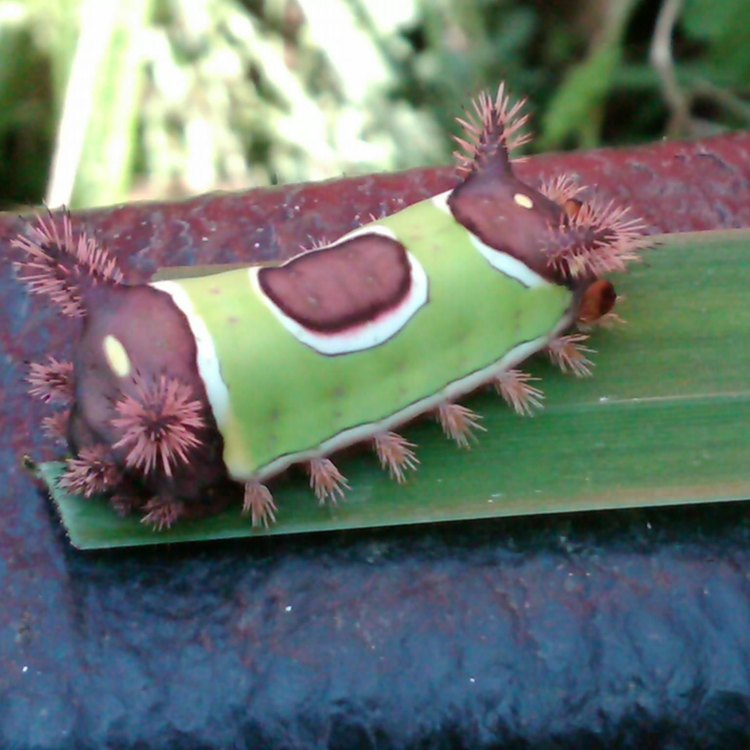
The Intriguing World of the Saddleback Caterpillar
Disclaimer: The content provided is for informational purposes only. We cannot guarantee the accuracy of the information on this page 100%. All information provided here may change without prior notice.



